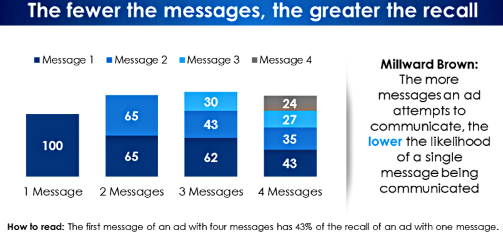The CUMULUS MEDIA | Westwood One Audio Active Group has tested hundreds of audio ads over the years working with the leading experts in creative testing: ABX, Veritonic, and Sensory Logic. The findings from those tests, along with marketing effectiveness and creative strategy work from industry giants like Les Binet, Peter Field, Alice Sylvester, Bryon Sharp, Leslie Wood, Paul Feldwick, Jenni Romaniuk, and Orlando Wood, have been combined to form CUMULUS MEDIA | Westwood One Audio Active Group’s comprehensive Audio Creative Best Practices.

When developing creative, keep these strategies in mind for high quality audio:
Ad length plays a minor role: The most asked question has the smallest impact on marketing effectiveness
The most frequently asked question about creative is about ad length. 15-second ads versus 30-second ads versus 60-second ads. Which is better? This question is often asked without any context.
Creative tests show only a modest benefit between 30-second ads versus 60-second ads. Hundreds of podcast brand effect studies conducted by Nielsen finds 30-second ads achieve nearly the same ad recall and purchase intent of 60-second ads.
Don’t get caught up on spot length. In the grand scheme of audio creative, the length of an ad is a minor factor in effectiveness. Instead, focus on the number of messages included, the mix of brand building and sales activation, and utilizing emotional copy over rational messaging to influence the effectiveness of creative.
Don’t worry about wear-out
Wear-out is the point where creative performance declines by 50% from its peak. This occurs because of listener fatigue due to message frequency in a continuous time period.
The best way to avoid wear-out? Develop quality creative. The better the audio creative, the longer the ad can run. Pre-test the audio and then test it again in six months. If the creative is high quality, the scores will be stable.
In their book How Not To Plan: 66 Ways To Screw It Up, Les Binet and Sarah Carter report on the non-issue of wear-out: “Millward Brown concludes that genuine wear-out is rare, and limited to ‘new news’ ads. Campaigns are more likely to wear in than out.”

The fewer messages, the better the advertising recall
Creative testing giant Millward Brown reports the more messages an ad attempts to convey, the lower the likelihood of a single message being communicated. Their data shows that the first message in an ad with four messages has only 43% of the recall of an ad with one message.
The more messages crammed into an ad, the less likely consumers can recall the messages. A 15-second ad with one simple message will generate better recall than a 30-second ad with three or four messages.
Chris Smith, Principal and Chief Creative Officer at Plot Twist Creativity, advises his clients with his own audio creative best practices including: “Be single-minded: say one thing.” He explains, “A lot of advertisers think that because radio affords you sixty or thirty seconds, they have the time to say everything there is to say about their brand. It’s why so many commercials end up sounding like laundry lists. The truth is, if you want to talk about everything, then you really have nothing to talk about. In advertising, you need to have one thing to say. AM/FM radio’s sixty seconds of ad time just gives you the chance to say it in an entertaining and memorable way.”
He cites this Snickers ad to illustrate the point: “They have one idea – you’re not at your best when you’re hungry. They spend most of the ad being entertaining, holding the attention of the audience, and serving the one central idea.”
Brand building campaigns, the “protein of advertising,” overperform sales activation
Analytic Partners, one of the world’s largest and most prestigious marketing mix modelers, reveals that brand messaging outperforms performance messaging 80% of the time. Of the two types of campaigns, brand building is harder to achieve, requires greater investment, and is more important.
According to Binet and Field, “Brand building means creating mental structures (associations, memories, beliefs, etc.) that will pre-dispose potential customers to choose one brand over another. This is a long-term job involving conditioning consumers … so it takes time; talking to people long before they come to buy.”
Brand building requires mass reach media like television and AM/FM radio because the goal is to target everyone in the category, even if they are not in the market right now. While short-term sales uplifts are smaller, brand building sales effects (the blue line below) grow and grow over time, becoming the main driver of long-term growth and profit.

Focus creative on emotional messaging versus rational
Building top of mind recall and brand awareness is all about reach. Ensuring that a brand is liked and understood is the job of brand advertising. Are brands built with facts and logical assertions or with emotion-based storytelling?
The Binet and Field analysis found that emotional campaigns build brands more strongly regardless of the measure: awareness, commitment, trust, differentiation, fame, or image. Emotional campaigns are far more powerful at building brands. They create emotional bonds and associations.
Key takeaways:
- Have a conversation: Don’t shout
- The first five seconds matter: Say the brand early and often
- Don’t get caught up on spot length
- The fewer the messages, the greater the recall
- Use consistent, unified creative across different media to deliver impact
- Tell a story with emotion
- Use a fluent device, ie. a recurring character or scenario
- Entertain for emotional gain
- Make the ad audible and easy to understand
- Use music for branding
- Create a sonic logo with melody that says the name of the brand
- Leverage the appeal and trust of AM/FM radio personalities and podcast hosts
- Target your core audience: Women prefer a female voice
- Don’t worry about wear-out
No comments:
Post a Comment
Note: Only a member of this blog may post a comment.